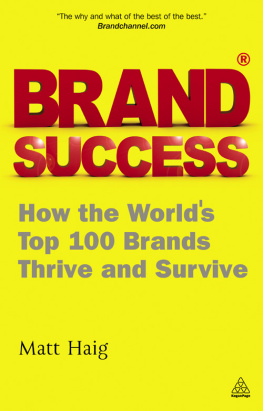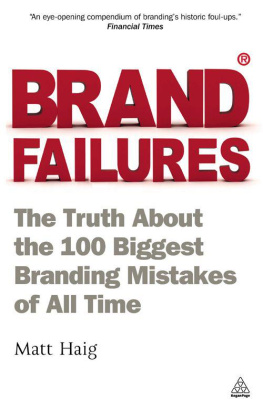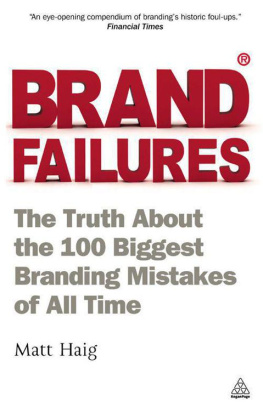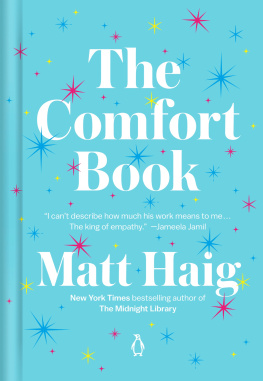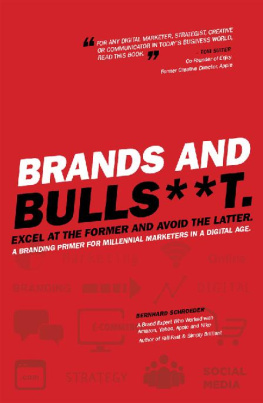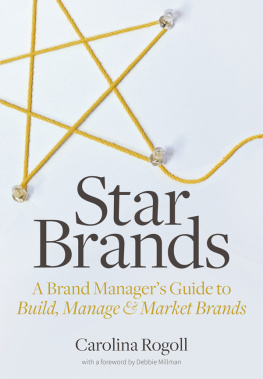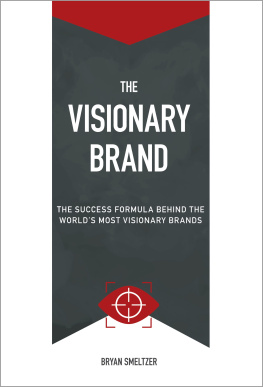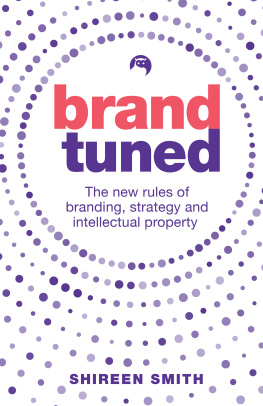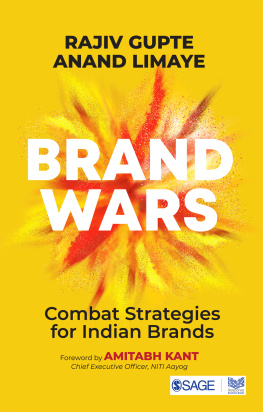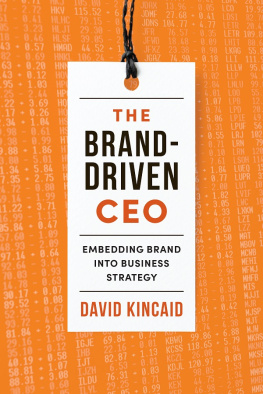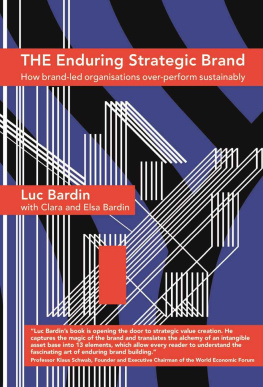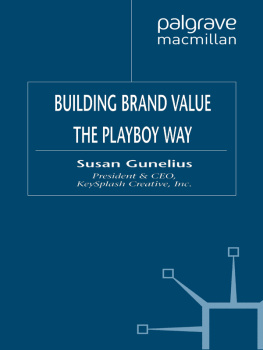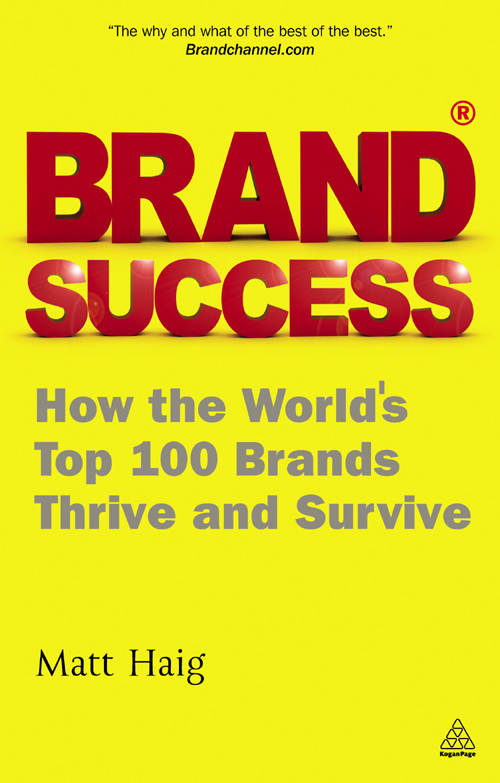Note on the Ebook Edition
For an optimal reading experience, please view large
tables and figures in landscape mode. |
This ebook published in 2011 by
Kogan Page Limited
120 Pentonville Road
London N1 9JN
UK
www.koganpage.com
Matt Haig, 2004, 2011
E-ISBN 9780749462888
Contents
Being good in business is the most fascinating kind of art. (ANDY WARHOL)
B randing is now the most important aspect of business. Though identifying what exactly makes a brand work is pretty tricky, as no two brands are the same.
However, by focusing on 100 of the most successful brands, the difference between them becomes astoundingly clear.
The simple ready-made solutions of the brand gurus start to unravel. You look at Hoover or Gillette or Coca-Cola and you think Ah yes, of course, the secret to a successful brand is to invent a completely new type of product. And then you look at Mercedes-Benz or Nike or Pepsi and realize you can build a successful brand around someone elses invention.
You then think that maybe the secret to a successful brand is to be associated with one type of product or service. You look at brands such as Rolex, Kleenex, Wrigleys, Colgate, Mot & Chandon, Hertz and Bacardi and you think: At last! Thats it! Thats the secret! One type of product per brand! And then your heart sinks as you think of Yamaha and Caterpillar and Virgin, all of which produce widely different types of products.
Ultimately, the examples in this book are successful not because they conform to a neat little set of laws that apply to all brands but because they follow their own individual path with confidence. Successful brands are similar in that they all have a clear vision, but that vision is never the same.
It is precisely this lack of universal conformity that turns branding, and the business it generates, into the fascinating kind of art Andy Warhol once spoke about.
While branding may be an art, it also owes a debt to religion. Indeed, you could easily be fooled into thinking that many brands want to be mini-religions in themselves. Looking at 100 brands therefore starts to feel like looking at 100 very different religious cults. Consider the following characteristics:
- Faith . Like religions, brands want people to have faith in what they have to offer. This faith ideally leads to life-long devotion and belief in the brands authenticity. Think of the attempts to position brands as the real thing (Coca-Cola) or the truth (Budweisers true slogan).
- Omnipresence . Successful brands want to be everywhere, and many have already achieved this aim. For example, the golden arches of McDonalds are now more recognized around the globe than the crucifix.
- Gurus . Successful brand managers are no longer called captains of industry. They are gurus to be worshipped devoutly by customers and employees alike. Religions were often founded by bearded men with enigmatic smiles who initiated virgin worship. Today we have Richard Branson.
- Goodness . Religion preaches good will to all people. Conscience brands such as The Body Shop, Cafdirect and Seeds of Change also appeal to our philanthropic instincts.
- Purity . Brands, like religion, often centre around the pursuit of purity. Sometimes, as in the case of Evian and malt whisky, it is all about the purity of the product. More often, it is about the purity of the message, stripping a whole brand identity to a one-sentence strapline or a singular image.
- Places of worship . It is no longer enough for brands to be sold in a shop; they now have their own places of worship. Disneyland was the first, arriving in the 1950s, but in the 21st century brand temples are everywhere. Consider the numerous Nike Towns where trainers are displayed on pillars rising from the ground. Or think of state-of-the-art car showrooms on the Champs-Elyses in Paris, complete with interactive games, wine bars and restaurants.
- Icons . Iconic figures from the world of sport or entertainment attract the kind of devotion once reserved for saints and prophets. Celebrities such as Tiger Woods, David Beckham and P Diddy not only endorse brands, but are brands themselves with a market value most companies can only dream of.
- Miracles . Religion promises the miraculous. Even when the M word isnt mentioned, it is implied. From the multicultural nirvana offered by Benetton to the promise of a new body on the cover of a fitness DVD, consumers are asked to choose not only between products, but also between competing miracles.
Trust.
Its a wonderful word. Right up there with love and hope and happiness and all those other universal emotions. Its certainly a word used a lot in business books. In fact, it is so often used we sometimes ignore it, the way we dont think about the air we breathe. But we need to think about it, now more than ever, because it is a rarer commodity than a lot of people realize. And yet it is now the single most important thing when it comes to brand success. People have lost a lot of trust in the business world in general, and are more discerning about how they spend their (often vulnerable) income.
Since the first edition of this book the world of brands has been transformed. But the brands I chose back then remain successful for the qualities I recognized. Mainly, they inspired trust, and trust unlike love and hope is a very rational emotion. If a company lets you down, you dont trust them anymore. If they are misleading, or greedy, or leak oil into the sea, then the brand is going to get hit harder now than ever before. And the global economic meltdown has seen many big names crash and burn.
This is already old news.
Here the focus is on the smart guys. The ones we still trust, who havent managed to be tarred with the same brush as the short-term boom-riders, fast-buck scammers and lethargic dinosaurs who havent fared so well. And as the perception of brands and business has changed more among those in the financial sector than anywhere else, its worth having a glance at those financial brands giving off positive vibes and making positive growth at a time when many would have thought it near-impossible.
More important still, look where theyre coming from.
While long-established dinosaurs such as Lehman Brothers, respected and feared on Wall Street since before 1929, have become extinct, a host of new names have sprung up to take their place. Bank of China, first listed on the Hong Kong stock market in 2002, was the worlds 24th most valuable brand in 2010, just behind HSBC, but well ahead of Citibank. That same year ICICI, Indias largest bank by market capitalization, entered the listings as the 45th most valuable brand. So for the first time since its inception in 2006, the BrandZ Top 100, who provide the most objective annual study of brand value and positioning, include brands from new markets such as Russia, India and China. With this in mind this edition has a new section devoted exclusively to brands from emerging markets.
Trust, though, remains key.
Indeed, the global meltdown has revealed some important facts about the economic resilience of established brands. Warren Buffets statement its not until the tide goes out that you can see who is swimming naked could be aptly applied here (though whenever I think of that phrase I get an image of Warren Buffet naked, which isnt helpful). The share prices of the top 100 brands as identified in the BrandZ study have outperformed the S&P 500 by over 30 per cent over the period 20052010. In fact, while companies in the S&P 500 lost 11.5 per cent in value, those of the top 100 brands gained 18.5 per cent. The reasons for such smooth sailing in choppy seas? Well, the perception of the brand.

